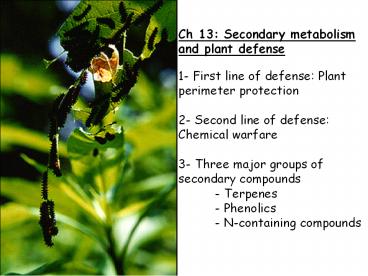Plant Defense PowerPoint PPT Presentation
Title: Plant Defense
1
Ch 13 Secondary metabolism and plant defense 1-
First line of defense Plant perimeter
protection 2- Second line of defense Chemical
warfare 3- Three major groups of secondary
compounds - Terpenes - Phenolics -
N-containing compounds
2
Agricultural pests economic damage - cost
of prevention and eradication
Cotton boll weevil
3
Fig. 11.13
4
Fig. 13.4
5
(No Transcript)
6
Classes of plant defenses PHYSICAL
DEFENSES Spines, thorns cutins waxes suberins SEC
ONDARY METABOLITES Phenolics Defense-related
proteins phenolic glycosides
peroxidases bound phenolics polyphenol
oxidase lignin? PAL condensed
tannins hydrolysable tannins Terpenes
N-containing monoterpenes Alkaloids
diterpene acids Mustard oils
7
Physical Defenses
8
Stem spines Colletia paradoxa
Leaf spines- Opuntia invicta
Shoot spines- Dovyalis caffra Otherwise known as
kei apple Drought tolerant
9
A closer look
10
- Why did spines often evolve in areas that are dry
or in other ways stressful? - Other roles - competition, camouflage?
11
Waxes, Cutins, and Suberins
12
Cutin, Waxes, Suberins are made of hydrophobic
compounds
- Hydrophobic having water-repelling properties
- These compounds are non-polar
- Fatty acids are one type of hydrophobic compound
13
(No Transcript)
14
Cutin
- composed of long fatty acid chains
- a major component of plant cuticle
15
(No Transcript)
16
(No Transcript)
17
Cutin
- Plants cuticles often vary with the climate in
which they live.
Cactus cuticle
Cactus cuticle
18
Waxes
- complex mixtures of long-chain lipids that are
extremely hydrophobic. - are synthesized by epidermal cells.
- exuded through pores in the epidermal cell wall
by an unknown mechanism.
19
(No Transcript)
20
Suberin
- Also formed from fatty acids but has a different
structure from cutin. - A cell wall constituent.
21
(No Transcript)
22
Suberin
- often within roots.
- can protect against pathogens and other damage.
- older parts of roots more suberized
- endodermis has suberin side walls, water
- must pass through plasma membrane to get to
stele
23
Suberin can form transport barriers between the
soil and the roots
24
Secondary Metabolites- a term that has stuck
25
Secondary Compounds are so-called becauseThey
do not play a role in photosynthesis, growth, or
respiration. HOWEVER
26
Sec Plant secondary metabolites ondary Compounds
- protect primary metabolism by deterring
herbivores, reduce tissue loss. - also attract pollinators and seed-dispersing
animals. - formed from the byproducts or intermediates of
primary metabolism (see figure 13.4)
27
(No Transcript)
28
Constitutive vs. Induced Defenses
Constitutive defense - always present
Induced defense - synthesized in response to
challenge
29
(No Transcript)
30
Terpenes
- Constituents of essential oils
- Building block- 5 C isoprene unit
- Terpenes are classified by the number of isoprene
units they have. - i.e. monoterpenes-1, diterpenes-4 etc.
31
Terpenes
- produced from the mevalonic acid pathway
- some functions in primary metabolism
- function as herbivore deterrents
- can be produced in response to herbivore feeding,
and to attract predatory insects and parasites of
the feeding herbivore.
32
(No Transcript)
33
(No Transcript)
34
Isoprene is the basic building block of the
terpenes (terpenes also called isoprenoids)
H3C
CH
CH
CH2
H2C
Monoterpenes have two C5 units (10C) Sesquiterpene
s have three C5 units (15C) Diterpenes have four
C5 units (20C) Triterpenes 30 C Tetraterpenes
40C Polyterpenes (C5n), ngt8
35
- Terpene functions
- Growth and development
- carotenoid pigments are tetraterpenes
- chlorophyll side chain is diterpene
- giberellins (hormones) are diterpenes
- abscissic acid (hormone) is a sesquiterpene C15
- sterols are triterpenes
36
- Terpene functions
- 2. As defensive compounds
- toxins and feeding deterrenets to insects and
mammals - Examples
- resins of conifers are monoterpenes
- essential oils - peppermint, limon, basil, sage
- may be in glandular hairs on epidermis
37
Non-volatile
Volatile
38
Non-volatile terpenes - limonene apparently
distasteful to herbivores
39
Volatile terpenes such as menthol broadcast a
smell that warns herbivores that the plant is
toxic to them before herbivore feeding commences.
40
- Phytoecdysones are plant steroids (within the
terpene class) that have the same basic structure
as insect molting hormones and thus interfere
with molting. These compounds sometimes cause
death of the insect herbivore.
41
- Terpenes such as pyrethrum (from chrysanthemums)
and azadirachtin (from the Asian and African Neem
tree) can be used as natural insecticides in
agricultural practices or in horticulture.
42
(No Transcript)
43
Terpenes that act against vertebrate herbivores
Triterpenes 1. cardenolides (glycosides) -
acutely toxic influence Na/K ATPase of heart
muscle medicinal application - digitalis
(from foxglove), used to treat heart disease.
Can slow and strengthen heart beat 2. Saponins
(soaplike) - steroid, triterpenes
glycosides have lipid and water soluble parts
of molecule toxicity related to sterol binding,
membrane disruption
44
(No Transcript)
45
Genomic Organization of Plant Terpene Synthases
and Molecular Evolutionary Implications Trapp
Croteau, 2001
Some 30,000 known terpenes. Phylogenetically
widespread. Common evolutionary origins may
predate angiosperms. Extensive gene duplication
events may drive the diversity.
46
Prior to divergence of gymnosperms and
angiosperms, during the carboniferous, the
duplication of an ancestral terpene synthase
geneoccurred. Once copy of the duplicated
ancestral gene remained highly conserved in
structure and function, and this gene may have
contemporary descendants in the terpene synthases
involved in giberellins biosynthesis. The second
ancestral gene copy diverged in structure and
function, by adaptive evolutionary processes, to
yield a large superfamily of terpene synthases
involved in secondary metabolic pathways.
47
Terpenes as human medicinal drugs
limonene - monoterpenoid (C10) dietary
anticarcinogen Artemisnin - sesquiterpenoid
(C15) antimalarial Taxol - diterpenoid
anticancer drug from Pacific yew (Taxus
brevifolia)
48
Taxol from Pacific Yew, Taxus brevifolia
Taxol was isolated from bark of Pacific Yew in
1970s. Taxol interferes with cell division by
binding to the protein tubulin, a key factor in
mitosis. Taxol and related compounds now widely
used in treating breast and ovarian cancer.

